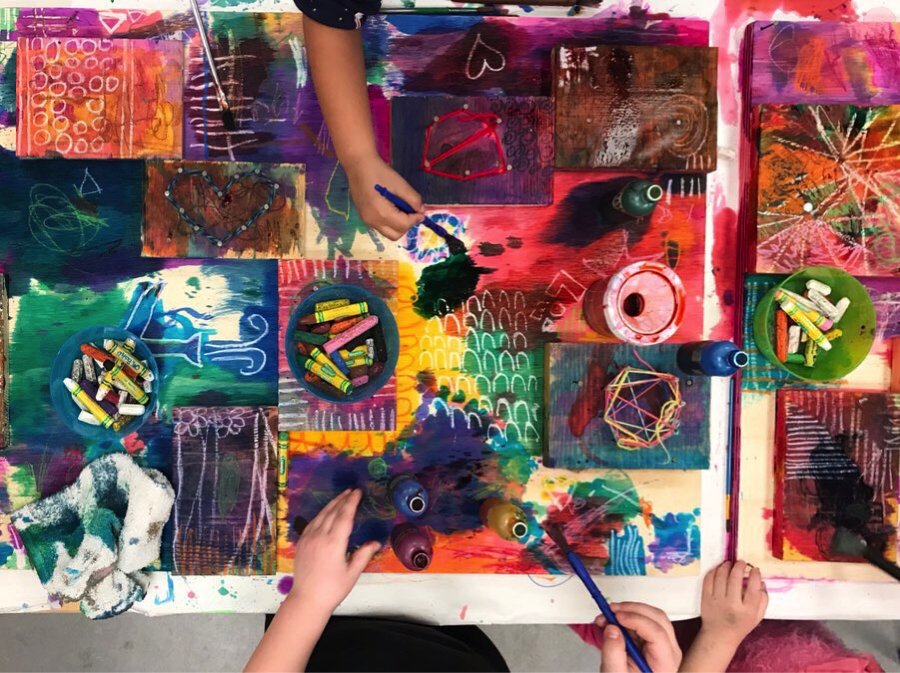Wild Wonders | Saturday, April 27

Wild Wonders | Saturday, April 27

By: Angela Lyonsmith, Artist-In-Residence
“Creative people are curious, flexible, persistent and independent with a tremendous sprit of adventure and a love of play” -Henri Matisse
The last month has provided many opportunities to be creative in The Studio at the Museum and beyond. We have had the chance to practice and develop important skills that range from communication and problem solving, to fine motor skills and creative thinking, while engaged in meaningful making. In February, we have focused on connections both in how we bring different types of materials together and how what we make can build a connection between makers and the recipients of their art.

This project offers many opportunities to explore, plan, and experiment as the process spans drawing, painting, using power tools, hammering, and drawing with nails and yarn. Here is what we did and how you can do it at home.
1. Select a piece of reclaimed wood.
2. Draw on the wood with oil pastels. You can make designs, lines & shapes or draw a picture.
3. Apply liquid watercolors in dab dispensers to add pigment to the wood. This step allows young artists to experiment with the process of watercolor resist and color mixing.
4. Decide what shape you want to “draw” with nails and yarn. Mark the wood for drilling holes.
5. Safely use a power drill to make the holes. (Even young makers can do this with guidance and extra hands for support.)
6. Place the nails in with your fingers and tap them in place with a hammer. This part is very popular with young artists.
7. Select the yarn colors you love. Start by tying your yarn to one nail and wrap around each nail tracing the perimeter or filling in the shape with yarn.
8. Ask your child questions about what they have made. For example: If you were to give this piece a title, what would it be? If you were to give this to someone, who would you give it to? Why? What part of making this did you enjoy the most? What part was the most challenging? Why? What, if anything, would you change about it? If you were to give this piece of art a sound or a song, what would it sound like?
9. Write the artist’s name, date, title, recipient’s name and/or what they love about this person. Some of my favorite messages have included “first time using power tools” or “for my sister, hope you feel better and can play with me soon.”

I was lucky to get to take this project to Scott Elementary School with the wonderful team at DuPage Children’s Museum. Huge thank you to Dustin Thacker, Arts and Maker Specialist at DCM, and Katie Nichols, Art Educator at Scott Elementary. Working alongside these inspiring teachers, we had the opportunity to facilitate art making with three classes of first graders and find out what strategies they use to form connections. One of my favorite observations came from a young maker who shared that when we work or play beside each other we are connecting with those around us. This is brilliant, and simple and true.
The above image captures some of the energy and joy of sharing this project with more than 70 young makers. Please join us for an art opening in the Good Show! Gallery on Friday, March 13th from 6:00 – 8:00 p.m. to see this work and meet the artists. The exhibit will be on display through mid May 2020.

In preparation for the exhibition, we began working on a large “wooden quilt” using the same process with a rolling group of young makers. Again, we began with oil pastel and watercolor resist and eventually began drawing in lines of connection with nails and yarn. While I love this image, what is really incredible is the verbal and non-verbal communication going on while the children are navigating how to work together on a single piece of art.
This invitation creates multiple opportunities for practicing kindness through sharing, turn taking, observing, collaborating, problem solving, decision making, exercising patience, and figuring out how to resolve impasses in the imagery and in the interactions between makers. I love how art can provide this space to practice these important life skills and then also a tangible record of how a problem was solved. This is some of the important work of art play.
“Play is often talked about as if it were a relief from serious learning. But for children play is serious learning. Play is really the work of childhood.” ~Fred Rodgers

Hope to meet you and your little ones in The Studio soon!
Angela will be in The Studio:

